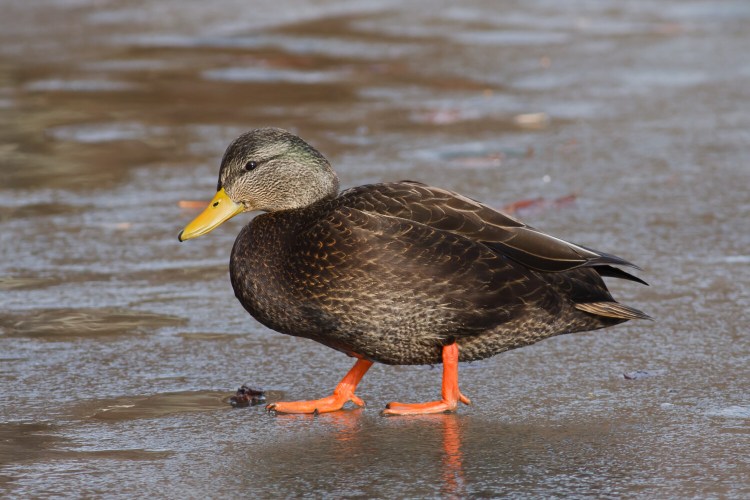What’s in a name? Lots, when it comes to distinguishing one species of duck from another, as each may have a different daily bag limit. Those names are supposed to be descriptive in a way that helps us distinguish one from another, but that’s not always the case.
Let’s start with the American black duck, one of our most common representatives. The “American” adjective addresses this avian’s affinity for living in our locale, though it clearly refers to the North American continent, not just our country, for the species is quite common in Canada as well, at least eastern Canada.
Black ducks rarely stray much west of the eastern half of the continent so they might just as well be called eastern American black ducks. As for the rest of the name, we know they’re ducks so is that really necessary? The mallard isn’t called a mallard duck; just a mallard. And closer inspection reveals that the black duck isn’t really black, but rather sports a mottled, dark brown plumage, not to be confused with the mottled duck, which looks more like a hen mallard, and rarely ventures much north of Florida and the Gulf Coast of Texas.
As for the scientific name, Anas rubripes, the genus Anas simply means: a duck. Pretty straightforward, and perhaps also unnecessary. The species name, rubripes, refers to the black duck’s red legs and feet, which isn’t all that helpful as it’s a trait common to the mallard and mottled duck as well, and in all three cases the appendages are more orange than red. Although, veteran New England waterfowlers still refer to the migrant black ducks that descend upon our marshes later in the season as “red legs,” despite biologists’s claims that there is no difference in color between residents, early migrants and late migrants.
Let’s go back to the mallard for a moment. The name is rooted in the word “male,” with the “ard” meaning bold or hardy, and not in a complimentary way. It is said to be suggestive of the male mallard’s habit of abandoning his mate once their physical union occurs, leaving her to care for the clutch and brood, a habit common to most duck species. And the mallard’s species name: “platyrynchos” refers to its wide, flat bill, another trait common to most ducks. The species name for the northern shoveler, which has far and away the widest, flattest bill of any duck, is clypeata, a reference to its white breast. Somehow that doesn’t seem right.

Finally, a well-named duck: “Hooded” seems a fairly apt term for the smallest of three North American mergansers.” Agami Photo Agency/Shutterstock
The wood duck most likely received its common name from its habit of nesting in tree cavities, a habit it shares with the hooded and common mergansers, common goldeneye and bufflehead. Speaking of which, “hooded” seems a fairly apt term for the smallest of three North American mergansers, which sports a puffy white crest or “hood.” The midsized red-breasted merganser, meanwhile, wears a brownish red bib. I guess the ornithologists were just tired of inventing names when they got to the larger common merganser, or the common goldeneye, or just about any bird with the first name “common.” As for the bufflehead, its head apparently resembles that of a buffalo. Sure.
Then there’s a group of diminutive ducks collective referred to as teal. According the references I found, the term is of Dutch origin and means: “teal.” Appropriate, I suppose, but not very creative. In this case, however, common names like green-winged, blue-winged and cinnamon are quite helpful in distinguishing members of this sub-family, until you notice the shoveler and cinnamon teal also sport blue wings.
American wigeon helps us distinguish this species from its Old World counterpart, the Eurasian wigeon. And the “wigeon” part is said to be a reference to its call being more of a whistle than the raspy clucking characteristic of most ducks. The origin of the name “gadwall” is described only as “obscure,” but suggested to be connected to a point or knob on the tip of the bill – another trait common to most ducks.
The name northern pintail aptly describes this species’ long, thin central tail feathers, and further distinguishes it from similar species more common in the Southern Hemisphere. However, the distinction became perhaps a bit more vague when ornithologists decided to rename another species the “long-tailed duck.” That was no doubt a nod to political correctness, but I still feel the former name, “old squaw” (a reference to the bird’s notoriously noisy voice) is colorful and more appropriately descriptive.
Among my most favorite when it comes to naming birds is the ring-necked duck. This small diver sports a distinctive white ring, on its bill. If you look really closely, at one in your hand, you can barely make out a faint buffy stripe between the black breast and dark purple head. Apparently, this species was named at a time when the popular convention was to label birds based on very subtle characteristics. In the final analysis, that seems like as good an approach as any.
Bob Humphrey is a freelance writer and Registered Maine Guide who lives in Pownal. He can be reached at:
bhunt@maine.rr.com
Comments are not available on this story.
Send questions/comments to the editors.


